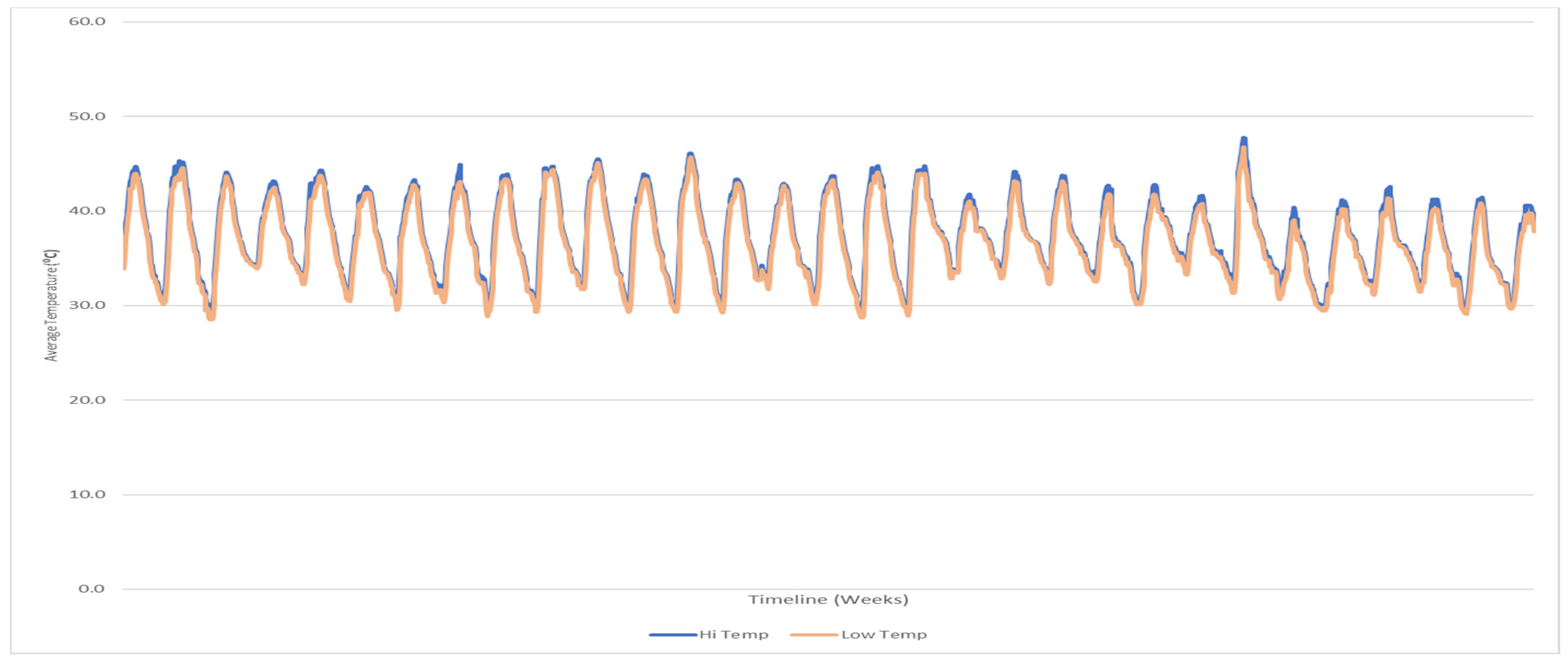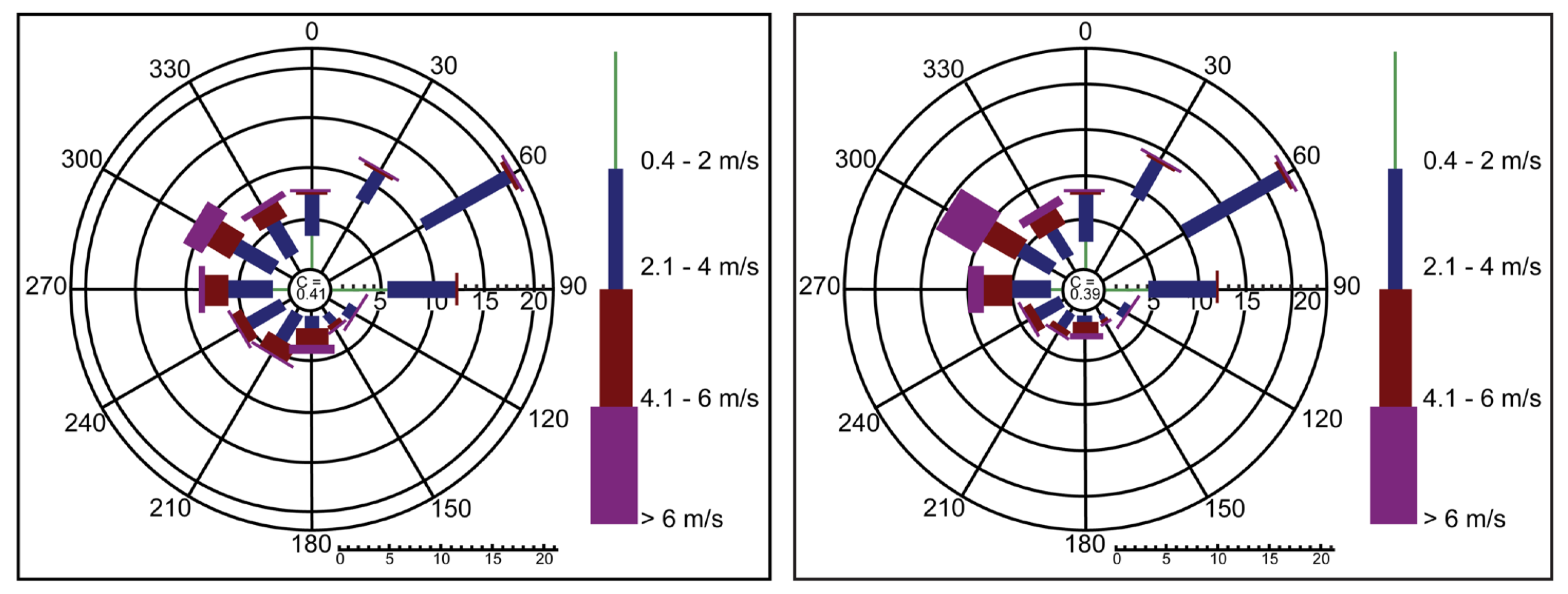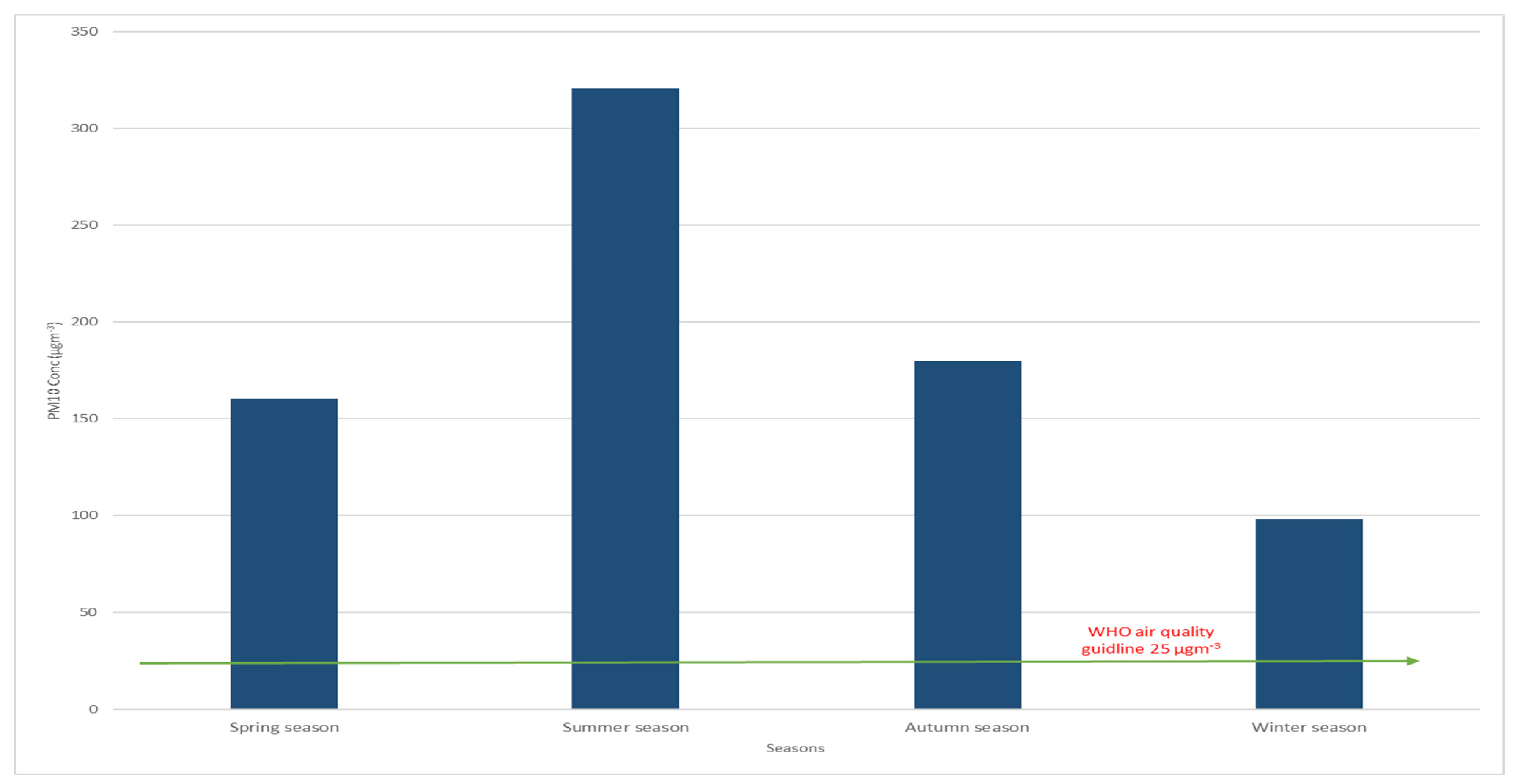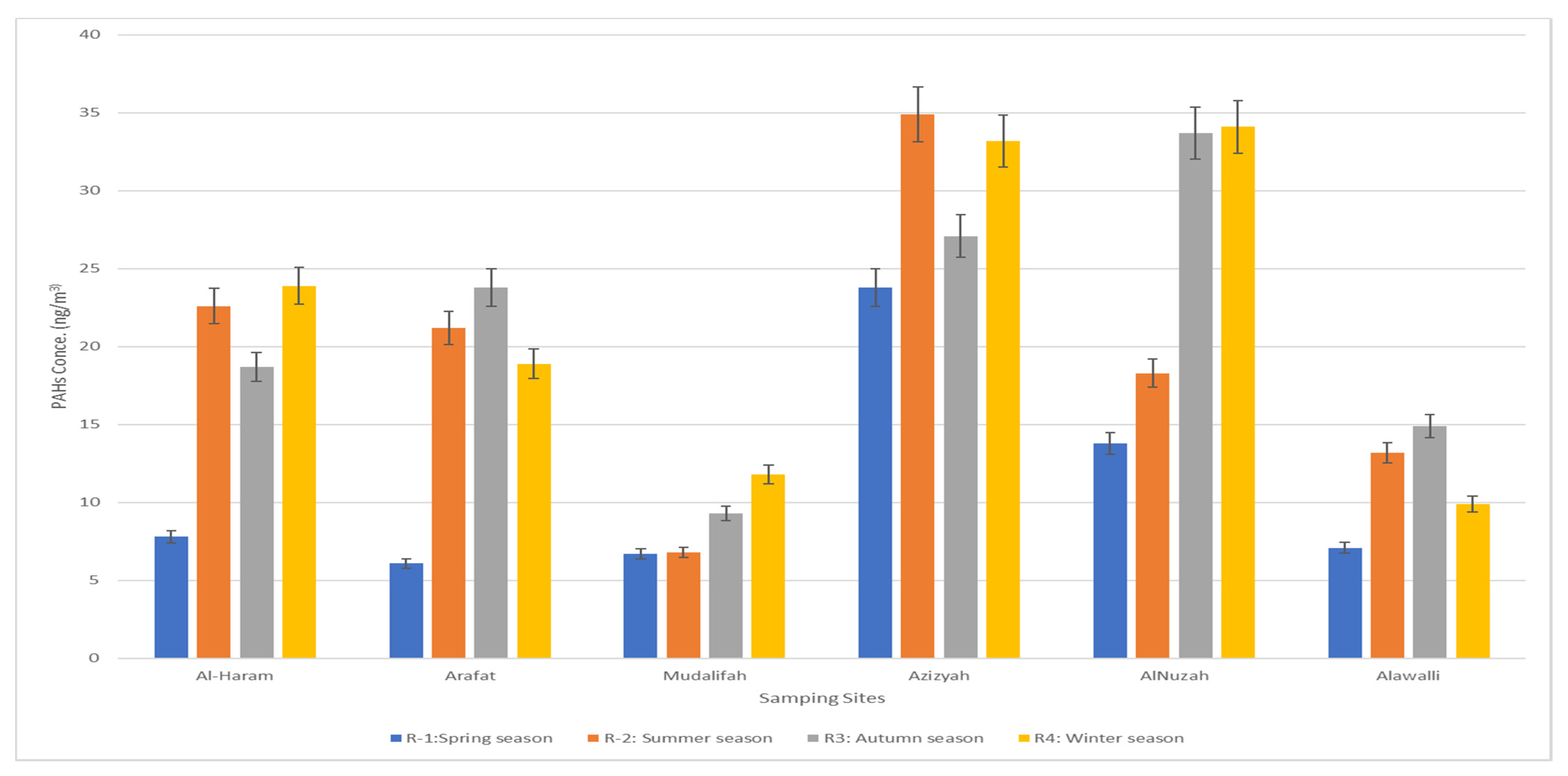Evaluation of Carcinogenic Polyaromatic Hydrocarbon Levels in Airborne Particulates Associated with Long-Term Exposure throughout the COVID-19 Pandemic in Makkah, Saudi Arabia
Abstract
1. Introduction
1.1. Different Sources of Polyaromatic Hydrocarbons
1.2. PAH Distribution in Environment
1.3. PAHs and Human Exposure
1.4. PAHs and Human Health
1.5. Hydrocarbon Carcinogenicity
2. Materials and Methods
2.1. Air Sampling Protocol
2.1.1. Meteorological Parameters
2.1.2. Polyaromatic Hydrocarbon (PAH) Air Sampling
2.2. Laboratory Analysis Methods
2.2.1. Quality Control Measures
2.2.2. Statistical Analysis
3. Results and Discussion
3.1. PM10 levels and Seasonal Variations
3.2. PAHs and Seasons Changes
4. Conclusions
Author Contributions
Funding
Institutional Review Board Statement
Data Availability Statement
Conflicts of Interest
References
- Xue, W.L.; Warshawsky, D. Metabolic activation of polycyclic and heterocyclic aromatic hydrocarbons and DNA damage: A review. Toxicol. Appl. Pharmacol. 2005, 206, 73–93. [Google Scholar] [CrossRef]
- Hassan, S.K. Atmospheric Polycyclic Aromatic Hydrocarbons and Some Heavy Metals in Suspended Particulate Matter in Urban, Industrial and Residential Areas in Greater Cairo. Ph.D. Thesis, Cairo University, Cairo, Egypt, 2006. [Google Scholar]
- Esen, F.; Tasdemir, Y.; Vardar, N. Atmospheric concentrations of PAHs, their possible sources and gasto- particle partitioning at a residential site of Bursa, Turkey. Atmos. Res. 2008, 88, 243–255. [Google Scholar] [CrossRef]
- Kyrtopoulos, S.A.; Georgiadis, P.; Autrup, H.A.; Demopoulos, N.; Farmer, P.; Haugen, A.; Katsouyanni, K.; Lambert, B.; Ovrebo, S.; Sram, R.; et al. Biomarkers of genotoxicity of urban air pollution: Overview and descriptive data from a molecular epidemiology study on populations exposed to moderate to low levels of polycyclic aromatic hydrocarbons (the AULIS project). Mutat. Res. 2001, 496, 207–228. [Google Scholar] [CrossRef]
- Sram, R.J.; Binkova, B. Molecular epidemiology studies on occupational and environmental exposure to mutagens and carcinogens, 1997–1999. Environ. Health Perspect. 2000, 108 (Suppl. 1), 57–70. [Google Scholar]
- Armstrong, B.G.; Hutchinson, E.; Unwin, J.; Fletcher, T. Lung Cancer Risk after Exposure to Polycyclic Aromatic Hydrocarbons: A Review and Meta-Analysis. Environ. Health Perspect. 2004, 112, 970–978. [Google Scholar]
- CCME (Canadian Council of Ministers of the Environment). Canadian Soil Quality Guidelines for Potentially Carcinogenic and Other PAHs: Scientific Criteria Document; CCME: Winnipeg, MB, Canada, 2010.
- Latimer, J.; Zheng, J. The Sources, Transport, and Fate of PAH in the Marine Environment; Douben, P.E.T., Ed.; John Wiley and Sons Ltd.: New York, NY, USA, 2003. [Google Scholar]
- Masih, J.; Singhvi, R.; Kumar, K.; Jain, V.K.; Taneja, A. Seasonal Variation and Sources of Polycyclic Aromatic Hydrocarbons (PAHs) in Indoor and Outdoor Air in a Semi Arid Tract of Northern India. Aerosol. Air Qual. Res. 2012, 12, 515–525. [Google Scholar] [CrossRef]
- Masih, J.; Masih, A.; Kulshrestha, A.; Singhvi, R.; Taneja, A.J. Seasonal Variation and Sources of Polycyclic Aromatic Hydrocarbons (PAHs) in Indoor and Outdoor Air in a Semi Arid Tract of Northern India. Hazard. Mater. 2010, 177, 190–198. [Google Scholar] [CrossRef]
- Akyuz, M.; Cabuk, H. Gas-particle partitioning and seasonal variation of polycyclic aromatic hydrocarbons in the atmosphere of Zonguldak, Turkey. Sci. Total Environ. 2010, 408, 5550–5558. [Google Scholar]
- Tolosa, I.; Bayona, J.M.; Albaiges, J. Particulate Fluxes of Aliphatic and Aromatic Hydrocarbons in Near-shore Waters to the Northwestern Mediterranean Sea, and the Effect of Continental Runoff. Environ. Sci. Technol. 1996, 30, 2495–2503. [Google Scholar] [CrossRef]
- WHO (World Health Organization). Polynuclear Aromatic Hydrocarbons in Drinking-Water. Background Document for Development of WHO Guidelines for Drinking-Water Quality; [WHO/SDE/WSH/03.04/59]; WHO: Geneva, Switzerland, 2003. [Google Scholar]
- Masih, A.; Taneja, A. Assessment of Environmental Sources, Levels and Distribution of Polycyclic Aromatic Hydrocarbons within Nzoia Catchment Area in Kenya. Chemosphere 2006, 65, 449–456. [Google Scholar] [CrossRef]
- Seo, J.S.; Keum, Y.S.; Harada, R.M.; Li, Q.X. Isolation and characterization of bacteria capable of degrading polycyclic aromatic hydrocarbons (PAHs) and organophosphorus pesticides from PAH-contaminated soil in Hilo, Hawaii. J. Agric. Food Chem. 2007, 55, 5383–5389. [Google Scholar] [CrossRef] [PubMed]
- Zhang, Y.; Tao, S. Global atmospheric emission inventory of polycyclic aromatic hydrocarbons (PAHs). Atmos Environ. 2009, 43, 812–819. [Google Scholar] [CrossRef]
- Ravindra, K.; Sokhi, R.; Grieken, R.V. Atmospheric polycyclic aromatic hydrocarbons: Source attribution, emission factors and regulation. Atmos. Environ. 2008, 42, 2895–2921. [Google Scholar] [CrossRef]
- Wang, Z.; Ren, P.; Sun, Y.; Ma, X.; Liu, X.; Na, G. Gas/particle partitioning of polycyclic aromatic hydrocarbons in coastal atmosphere of the north Yellow Sea, China. Environ. Sci. Pollut. Res. 2013, 20, 5753–5763. [Google Scholar] [CrossRef]
- Wang, Z.; Yang, C.; Yang, Z.; Sun, J.; Hollebone, B.; Brown, C.; Landriault, M.J. Forensic fingerprinting and source identification of the 2009 Sarnia (Ontario) oil spill. Environ. Monit. 2011, 13, 3004–3017. [Google Scholar]
- Kameda, T.J. Atmospheric Chemistry of Polycyclic Aromatic Hydrocarbons and Related Compounds. Health Sci. 2011, 57, 504–511. [Google Scholar] [CrossRef]
- Kuo, C.Y.; Chien, P.S.; Kuo, W.C.; Wei, C.T.; Jui-Yeh, R.J.Y. Comparison of polycyclic aromatic hydrocarbon emissions on gasoline- and diesel-dominated routes. Environ. Monit. Assess. 2012, 185, 5749–5761. [Google Scholar] [CrossRef] [PubMed]
- Schwarzenbach, R.P.; Gschwend, P.M.; Imboden, D.M. Environmental Organic Chemistry; John Wiley and Sons, Inc.: Hoboken, NJ, USA, 1993. [Google Scholar]
- ACGIH (American Conference of Governmental Industrial Hygienists). Polycyclic Aromatic Hydrocarbons (PAHs) Biologic Exposure Indices (BEI) Cincinnati; American Conference of Governmental Industrial Hygienists: Cincinnati, OH, USA, 2005. [Google Scholar]
- Lannerő, E.; Wickman, M.; van Hage, M. Exposure to environmental tobacco smoke and sensitisation in children. Thorax 2008, 63, 172–176. [Google Scholar] [CrossRef]
- Ciecierska, M.; Obiedziński, M.W. Polycyclic aromatic hydrocarbons in the bakery chain. Food Chem. 2013, 141, 1–9. [Google Scholar] [CrossRef]
- Wang, Y.; Tian, Z.; Zhu, H.; Cheng, Z.; Kang, M.; Luo, C. Polycyclic aromatic hydrocarbons (PAHs) in soils and vegetation near an e-waste recycling site in South China: Concentration, distribution, source, and risk assessment. Sci. Total Environ. 2012, 439, 187–193. [Google Scholar] [CrossRef]
- Bozlaker, A.; Muezzinoglu, A.; Odabasi, M. Atmospheric concentrations, dry deposition and air–soil exchange of polycyclic aromatic hydrocarbons (PAHs) in an industrial region in Turkey. J. Hazard. Mater. 2008, 153, 1093–1102. [Google Scholar] [CrossRef] [PubMed]
- IARC (International Agency for Research on Cancer). Some non-heterocyclic polycyclic aromatic hydrocarbons and some related exposures. Monogr. Eval. Carcinog. Risks Hum. 2010, 92, 765–771. [Google Scholar]
- Benedetti, M.; Martuccio, G.; Fattorini, D.; Canapa, A.; Barucca, M.; Nigro, M.; Regoli, F. Oxidative and modulatory effects of trace metals on metabolism of polycyclic aromatic hydrocarbons in the Antarctic fish Trematomus bernacchii. Aquat. Toxicol. 2007, 85, 167–175. [Google Scholar] [CrossRef] [PubMed]
- Unwin, J.; Cocker, J.; Scobbie, E.; Chambers, H. An assessment of occupational exposure to polycyclic aromatic hydrocarbons in the UK. Ann. Occup. Hyg. 2006, 50, 395–403. [Google Scholar]
- IPCS (International Programme on Chemical Safety). Polycyclic Aromatic Hydrocarbons Selected Non-Heterocyclic. 2010. Available online: http://www.inchem.org/documents/ehc/ehc/ehc202.htm (accessed on 1 October 2021).
- Bach, P.B.; Kelley, M.J.; Tate, R.C.; McCrory, D.C. Screening for lung cancer: A review of the current literature. Chest 2003, 12, 72–82. [Google Scholar] [CrossRef]
- Diggs, D.L.; Huderson, A.C.; Harris, K.L.; Myers, J.N.; Banks, L.D.; Rekhadevi, P.V. Polycyclic aromatic hydrocarbons and digestive tract cancers: A perspective. J. Environ. Sci. Health C Environ. Carcinog. Ecotoxicol. Rev. 2011, 29, 324–357. [Google Scholar] [CrossRef]
- Olsson, A.C.; Fevotte, J.; Fletcher, T.; Cassidy, A.; Mannetje, A.; Brennan, P. Occupational exposure to polycyclic aromatic hydrocarbons and lung cancer risk: A multicenter study in Europe. Occup. Environ. Med. 2010, 67, 98–103. [Google Scholar] [CrossRef]
- US EPA (Environmental Protection Agency). Polycyclic Aromatic Hydrocarbons (PAHs)—EPA Fact. Sheet; National Center for Environmental Assessment: Washington, DC, USA , 2008.
- Burchiel, S.W.; Luster, M.I. Signaling by Environmental Polycyclic Aromatic Hydrocarbons in Human Lymphocytes. Clin. Immunol. 2001, 98, 2–10. [Google Scholar] [CrossRef]
- Miyata, M.; Furukawa, M.; Takahashi, K.; Gonzalez, F.J.; Yamazoe, Y. Mechanism of 7,12-dimethylbenz[a]anthracene-induced immunotoxicity: Role of metabolic activation at the target organ. J. Pharmacol. 2001, 86, 302–309. [Google Scholar] [CrossRef] [PubMed]
- Heba, A.; Saleh, A.; Saati, A.; Fatani, S. Cancer Risk of Inhalation Exposure to Cd, Cr, As, Be and Ni in Ambient Air. J. Environ. Prot. 2017, 8, 290–300. [Google Scholar]
- Board of Scientific Counselors Reports on Carcinogens; National Toxicology Program: Durham, NC, USA, 2002.
- Habeebullah, T.M.A. Risk assessment of Poly Cyclic Aromatic Hydrocarbons in the Holy City of Makkah, Saudi Arabia. Int. J. Environ. Sci. Dev. 2013, 4, 139. [Google Scholar] [CrossRef][Green Version]
- Yang, H.H.; Lai, S.O.; Hsieh, L.T.; Hsueh, H.J.; Chi, T.W. Profiles of PAH emission from steel and iron industries. Chemosphere 2002, 48, 1061–1073. [Google Scholar] [CrossRef]
- Khoder, M.I. Sources and distribution of polycyclic aromatic hydrocarbons in wet deposition in urban and suburban areas of Giza, Egypt. Cent. Eur. J. Occup. Environ. Med. 2006, 12, 279–296. [Google Scholar]
- Prahalad, A.K.; Ross, J.A.; Nelson, G.B.; Roop, B.C.; King, L.C.; Nesnow, S.; Mass, M.J. Dibenzo[a,l]pyrene-induced DNA adduction, tumorigenicity, and Ki-ras oncogene mutations in strain A/J mouse lung. Carcinogenesis 1997, 18, 1955–1963. [Google Scholar] [CrossRef] [PubMed][Green Version]
- International Agency of Research on Cancer (IARC). Monograph on Evolution of the Carcinogenic Risk of Chemicals to Human, Polynuclear Aromatic Mounds, Art 1; Chemical, Environmental and Experimental Data: Lyon, France, 1983; Volume 32, pp. 125–140. [Google Scholar]
- Algaissi, A.A.; Alharbi, N.K.; Hassanain, M.; Hashem, A.M. Preparedness and response to COVID-19 in Saudi Arabia: Building on MERS experience. J. Infect. Public Health 2020, 13, 834–838. [Google Scholar] [CrossRef]
- Saudi Center for Disease Prevention and Control (SCDC). Available online: https://covid19.cdc.gov.sa/daily-updates/ (accessed on 25 March 2020).
- Centers for Disease Control and Prevention. Saudi Arabia Fact Sheet. June 2020. Available online: https://www.cdc.gov/globalhealth/countries/saudi_arabia/default.htm (accessed on 1 October 2021).





| Sampling Locations | Location | Sampling Site Features |
|---|---|---|
| Al-Haram | 21°25′19.2″ N,39°49′33.6″ E | Intense traffic flow due to Hajj and Umrah seasons all year around |
| Arafat | About 20 km from Central Makkah | Intense transportation of trucks and buses based on Hajj season |
| Muzdalifah | 21°24′33″ N, 39°54′11″ E | Intense transportation of trucks and buses based on Hajj season |
| Aziziyah | 32°31′48″ N 1,3°0′36″ E | Domestic region with moderate traffic flow capacity excluding Hajj periods |
| Al Nuzhah | Nearly 5 km away from Al-Haram | Domestic, small business district with moderate to high-level commuter transportation capacity |
| Al Awali | 21°19′29″ N, 39°53′24″ E | Rural location has minimal transportation with small business-related activities |
| Measurements | Set 1 9 Weeks (Spring) | Set 2 10 Weeks (Summer) | Set 3 8 Weeks (Autumn) | Set 4 10 Weeks (Winter) |
|---|---|---|---|---|
| Temperature °C | 30.4 ± 1.56 | 39.5 ± 3.25 | 35.6 ± 1.88 | 29.1 ± 1.47 |
| Wind Speed (ms−1) | 6.5 ± 3.2 | 5.0 ± 1.3 | 6.6 ± 1.8 | 4.3 ± 1.7 |
| PM10 (µgm−3) | 120.1 ± 52.2 | 223.4 ± 30.4 | 77.6 ± 36.72 | 89 ± 62.7 |
Publisher’s Note: MDPI stays neutral with regard to jurisdictional claims in published maps and institutional affiliations. |
© 2021 by the authors. Licensee MDPI, Basel, Switzerland. This article is an open access article distributed under the terms and conditions of the Creative Commons Attribution (CC BY) license (https://creativecommons.org/licenses/by/4.0/).
Share and Cite
Adly, H.M.; Saleh, S.A.K. Evaluation of Carcinogenic Polyaromatic Hydrocarbon Levels in Airborne Particulates Associated with Long-Term Exposure throughout the COVID-19 Pandemic in Makkah, Saudi Arabia. Int. J. Environ. Res. Public Health 2021, 18, 12745. https://doi.org/10.3390/ijerph182312745
Adly HM, Saleh SAK. Evaluation of Carcinogenic Polyaromatic Hydrocarbon Levels in Airborne Particulates Associated with Long-Term Exposure throughout the COVID-19 Pandemic in Makkah, Saudi Arabia. International Journal of Environmental Research and Public Health. 2021; 18(23):12745. https://doi.org/10.3390/ijerph182312745
Chicago/Turabian StyleAdly, Heba Mohamed, and Saleh Ahmed K. Saleh. 2021. "Evaluation of Carcinogenic Polyaromatic Hydrocarbon Levels in Airborne Particulates Associated with Long-Term Exposure throughout the COVID-19 Pandemic in Makkah, Saudi Arabia" International Journal of Environmental Research and Public Health 18, no. 23: 12745. https://doi.org/10.3390/ijerph182312745
APA StyleAdly, H. M., & Saleh, S. A. K. (2021). Evaluation of Carcinogenic Polyaromatic Hydrocarbon Levels in Airborne Particulates Associated with Long-Term Exposure throughout the COVID-19 Pandemic in Makkah, Saudi Arabia. International Journal of Environmental Research and Public Health, 18(23), 12745. https://doi.org/10.3390/ijerph182312745







